 Arrays
Arrays
The purpose of this assignment is to introduce you to programming with one-dimensional arrays.
The StdAudio class uses a sampling rate of 44,100 Hz, which means
that every second of digital audio contains 44,100 samples.
You will use these two array-based functions for reading and playing audio samples:
StdAudio.read(filename) returns a double[] array containing
the samples (between –1 and +1) from the file specified as an argument.
StdAudio.play(samples) sends the double[] array of samples
to standard audio.
Write a program ReverseSoundWave.java that takes the name of
an audio file as a command-line argument and plays it in reverse order.
Your program should
StdAudio.read().
StdAudio.play().
Here are a few sample executions. Before running each example, make a prediction of what you think the reveresed audio will sound like.
~/Desktop/arrays> javac-introcs ReverseSoundWave.java ~/Desktop/arrays> java-introcs ReverseSoundWave A.wav ~/Desktop/arrays> java-introcs ReverseSoundWave AMajorScale.wav ~/Desktop/arrays> java-introcs ReverseSoundWave HelloWorld.wav ~/Desktop/arrays> java-introcs ReverseSoundWave ReverseHelloWorld.wav ~/Desktop/arrays> java-introcs ReverseSoundWave RowYourBoat.wav ~/Desktop/arrays> java-introcs ReverseSoundWave PacMan.wav
Playing music backward can sound creepy or demonic. On the other hand, playing a video backward is a popular effect on social media platforms such as TikTok.
Write a program Superpose.java that reads a number of
sound files (all of the same length) and plays the sound that results
by superposing those sounds together.
Your program should take the names of the sound files as command-line arguments.
~/Desktop/arrays> javac-introcs Superpose.java ~/Desktop/arrays> java-introcs Superpose SynthA.wav ~/Desktop/arrays> java-introcs Superpose SynthC#.wav ~/Desktop/arrays> java-introcs Superpose SynthE.wav ~/Desktop/arrays> java-introcs Superpose SynthA.wav SynthC#.wav SynthE.wav ~/Desktop/arrays> java-introcs Superpose TwinkleMelody.wav TwinkleHarmony.wav ~/Desktop/arrays> java-introcs Superpose PacMan1.wav PacMan2.wav ~/Desktop/arrays> java-introcs Superpose Bell1.wav Bell2.wav Bell3.wav ~/Desktop/arrays> java-introcs Superpose Crane1.wav Crane2.wav Crane3.wav Crane4.wav ~/Desktop/arrays> java-introcs Superpose InvertedSynthA.wav ~/Desktop/arrays> java-introcs Superpose SynthA.wav InvertedSynthA.wav
The resampling works as follows: If the existing sound has \(n\)
samples, then the new sound will have \(\lfloor n / \alpha\rfloor\) samples, and
sample \(i\) of the new sound corresponds to sample \(\lfloor\alpha \cdot i\rfloor\) of the existing sound
(both assume zero-indexing, i.e., that the first entry of the array corresponds to \(i = 0\)). As a reminder,
the floor function \(\lfloor x \rfloor\) returns the largest integer less than or equal to
\(x\). You can compute this function in Java by casting x to an
integer or by calling Math.floor(x).
Write a program ChipmunkEffect.java that takes two command-line arguments:
a string filename and a double alpha. Your program should change the speed of the
sound specified by the filename, and play the resampled sound.
Here are some sample executions:
~/Desktop/arrays> javac-introcs ChipmunkEffect.java ~/Desktop/arrays> java-introcs ChipmunkEffect KevinWayne.wav 1.0 ~/Desktop/arrays> java-introcs ChipmunkEffect KevinWayne.wav 1.5 ~/Desktop/arrays> java-introcs ChipmunkEffect SebastianCaldas.wav 1.0 ~/Desktop/arrays> java-introcs ChipmunkEffect SebastianCaldas.wav 1.7
This type of filter is a popular voice effect that you can apply on social media platforms such as TikTok.
For example, the following illustrates a perfect shuffle of an 8-card deck:
Amazingly, after perfectly shuffling a 52-card deck 8 times, the deck returns to its original order!
Write a program PerfectShuffle.java that takes two integer command-line arguments
\(m\) and \(n\), initializes a deck of \(m\) cards,
applies \(n\) perfect shuffles to the deck, and prints the results.
2, 3, 4, 5,
6, 7, 8, 9, T, J,
Q, K, A) followed by one character for the suit (C, D, H, S).
For example, 2C is the two of clubs and QH
is the queen of hearts.2C, the second is 3C, the 13th (if \(m \geq 13\)) is 2D and the last (if \(m = 52\)) is AS.
More precisely, on input m n, you must:
0, 2, 4, ..., m - 2 and the last \(m/2\) cards move to
positions 1, 3, 5, ..., m - 1.Here are some sample executions:
~/Desktop/arrays> javac-introcs PerfectShuffle.java ~/Desktop/arrays> java-introcs PerfectShuffle 8 0 2C 3C 4C 5C 6C 7C 8C 9C ~/Desktop/arrays> java-introcs PerfectShuffle 8 1 2C 6C 3C 7C 4C 8C 5C 9C ~/Desktop/arrays> java-introcs PerfectShuffle 8 2 2C 4C 6C 8C 3C 5C 7C 9C ~/Desktop/arrays> java-introcs PerfectShuffle 8 3 2C 3C 4C 5C 6C 7C 8C 9C ~/Desktop/arrays> java-introcs PerfectShuffle 52 4 2C 5D 8H JS 2D 5H ... JD AH 5C 8D JH AS ~/Desktop/arrays> java-introcs PerfectShuffle 52 8 2C 3C 4C 5C 6C 7C ... 9S TS JS QS KS AS
The perfect shuffle is useful in parallel processing algorithms, including the fast Fourier transform (which is widely used in science, engineering, and music). It is also used by magicians and card cheats.
Submission.
Submit
ReverseSoundWave.java,
Superpose.java,
ChipmunkEffect.java, and
PerfectShuffle.java.
Also submit a readme.txt file and answer the questions.
Do not use Java features that have not yet been introduced in the course
(such as functions).
Grading.
| File | Points |
|---|---|
| ReverseSoundWave.java | 9 |
| Superpose.java | 9 |
| ChipmunkEffect.java | 9 |
| PerfectShuffle.java | 9 |
| readme.txt | 4 |
| Total | 40 |
changeSpeed() function from Princeton's Conjunction Function assignment.